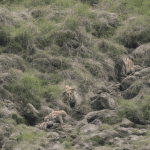In a world where social media reigns supreme, images have never had more power. The right photo can make people stop in their tracks, inspire them to action, and even change the world. While pictures of cute animals and stunning landscapes often fill our feeds, they do more than just provide a moment of distraction from our daily lives. As you delve into the realm of nature photography, you’ll find it plays a critical role in conservation efforts. This article explores how the lens of a camera has the potential to contribute to the preservation of wildlife and their natural habitats.
The Power of Images in Creating Awareness about Conservation
Imagine an image of an endangered animal, its eyes pleading for help, or a landscape showing the devastating impact of deforestation. Such photos stand as stark reminders of the effects of human activities on the planet’s wildlife and ecosystems. They serve as a wake-up call, stirring emotions, and prompting us to take action.
A voir aussi : Can Wearable Art and Fashion Influence Individual Identity and Mental Health?
In the era of digital media, photographs have the capacity to reach millions of people across the globe in an instant. Social media platforms, such as Instagram and Facebook, have become powerful tools for photographers to share their work and spread awareness about conservation issues. A single image can spark conversations, influence public opinion, and even effect policy changes.
Moreover, images have the ability to transcend cultural and language barriers, making them a universal medium for communication. This makes them particularly effective in promoting understanding and empathy towards animals and the environment, key elements in successful conservation efforts.
A lire également : Can Mosaic Art Improve Concentration?
The Role of Wildlife Photography in Documenting Species
Wildlife photography plays an essential role in documenting species, especially those that are threatened or endangered. Photographers often venture into remote, inaccessible areas to capture images of species that many of us would never otherwise see. These photos not only showcase the beauty and diversity of wildlife but also serve as valuable scientific records.
It is through such images that scientists can study and monitor animals in their natural habitats, gaining insights into their behaviours, diets, and mating patterns. These findings can inform conservation strategies, ensuring they are tailored to the specific needs of different species.
Furthermore, these images offer a glimpse into the state of our planet’s biodiversity. They enable us to track changes over time, providing visual evidence of the effects of climate change and other environmental threats on animal populations.
How Nature Photography Inspires People to Protect the Environment
Photographs have a unique ability to evoke emotions in people. A powerful image can make us feel a deep connection with the subject, whether it’s a majestic elephant in the wild or a delicate butterfly resting on a flower. By presenting wildlife and nature in all their splendor, photographers can inspire viewers to appreciate, love, and ultimately, work towards protecting the environment.
In addition, people are more likely to support conservation efforts if they understand what is at stake. By highlighting the beauty, complexity, and fragility of nature, photographers can help people see the value in preserving the natural world. They can also bring attention to the threats faced by wildlife and habitats, encouraging viewers to take action.
Moreover, by featuring images of conservation success stories, photographers can show that positive change is possible, reinforcing the belief that individual and collective actions can make a difference.
How Photographers Can Promote Conservation Ethically and Responsibly
While photography can be a powerful tool for conservation, it’s crucial that photographers follow ethical practices. This means respecting wildlife and their habitats, avoiding causing stress or harm to animals, and not disrupting natural processes.
Photographers should adhere to guidelines such as maintaining a safe distance from wildlife, not using bait to attract animals, and being mindful of their impact on the environment. They should also strive to portray animals and nature accurately and respectfully, avoiding sensationalism or misrepresentation.
In addition, photographers can leverage their influence on social media to promote responsible behaviour among their followers. They can educate their audience about conservation issues, encourage responsible tourism, and advocate for sustainable practices.
Leveraging the Impact of Nature Photography Through Collaborative Efforts
The impact of nature photography on conservation efforts can be amplified through collaborations between photographers, conservation organizations, and the media. By working together, they can reach a wider audience, raise more awareness, and generate more support for conservation initiatives.
Conservation organizations can use photographs to illustrate the importance of their work, attract funding, and engage the public in their campaigns. Meanwhile, the media can feature these images in their reporting, providing a visual context to their stories and making them more relatable to their audience.
By combining their skills, resources, and platforms, photographers, conservationists, and the media can create a strong and effective alliance for the benefit of nature conservation. Their combined efforts can make a significant impact, influencing public perceptions, inspiring change, and contributing to the protection of the planet’s wildlife and ecosystems.
In conclusion, it’s evident that nature photography can be a powerful tool in promoting conservation. The images captured by photographers can help raise awareness, inspire care for the environment, document species, and influence policy. However, it’s crucial that this is done ethically and responsibly, with utmost respect for the wildlife and habitats being photographed.
Nurturing the Bond Between Nature Photography and Wildlife Tourism
The symbiotic relationship between nature photography and wildlife tourism is an avenue that can significantly promote conservation. Tourists, armed with their cameras, are often eager to capture the breathtaking beauty of nature during their travels. These captivating images, when shared on social media platforms, can contribute significantly to raising awareness about the need for conservation.
However, it is essential that wildlife tourism is conducted responsibly to avoid causing harm to the environment or wildlife. Tour operators and tourists alike should adhere to guidelines that minimize disturbance to wildlife and their habitats. For instance, maintaining a safe distance from wildlife, not feeding or baiting animals, and staying within designated paths to avoid damage to fragile ecosystems.
Furthermore, tourists can be encouraged to participate in photo contests organized by conservation bodies, travel companies, and media organizations. These contests can serve dual purposes – they can stimulate interest in wildlife photography and simultaneously educate the public about various conservation issues. Winners of these contests can have their work featured in renowned publications, such as National Geographic, thereby reaching a wider audience.
In addition, photo stories or visual storytelling through photography can be a powerful way to convey the urgency of conservation. Tourists can share their unique experiences and observations through their photos, bringing to the fore the beauty, diversity, and vulnerability of our natural world.
Encouraging the Use of Nature Photography in Schools for Early Conservation Education
Integrating nature photography into the school curriculum can be an innovative approach to instilling an appreciation for nature and promoting conservation among younger generations. This hands-on, engaging activity can foster a sense of curiosity and respect for wildlife and natural habitats in children.
Schools could organize field trips to national parks or other natural areas, where students can try their hand at wildlife and landscape photography. These trips can be combined with lessons on ecology, biodiversity, and climate change, making learning an immersive and interactive experience.
Photographs clicked by the students can be used to create photo essays or exhibitions, showcasing the diversity of local flora and fauna, as well as highlighting any observable effects of environmental changes or threats. These student-led initiatives can raise awareness among peers, parents, and the local community, further broadening the reach of conservation messages.
Moreover, schools can collaborate with local nature photographers, wildlife conservation bodies, and media organizations for guest lectures, workshops, and mentorship programs. This can provide students with insights into the field of nature photography, including ethical considerations, technical skills, and the role of photography in conservation.
Conclusion: The Role of Nature Photography in Fostering a Conservation Ethic
In the age of the ubiquitous camera and social media, nature photography has the potential to be a potent tool in promoting conservation. The power of a single image to inform, inspire, and influence is undeniable. From raising awareness about endangered species and habitats, to documenting the impacts of climate change, to inspiring care and concern for the environment – the camera lens can capture it all.
However, it is paramount that nature and wildlife photography is conducted ethically and responsibly, ensuring minimum disturbance to wildlife and their habitats. Photographers, tourists, and students alike should adhere to established guidelines and principles for ethical wildlife photography.
Moreover, collaborations between photographers, conservationists, the media, schools, and tourism stakeholders can significantly amplify the impact of nature photography on conservation efforts. Such collective and concerted efforts are crucial to creating a sustainable future where humans live in harmony with nature. Through the power of the lens, we all can contribute to this shared vision.
As we continue to explore and appreciate the world around us through our cameras, let us remember that every photo holds a story – a story of nature’s resplendence, resilience, and the urgent need for its protection. Let’s ensure that these photo stories inspire not just admiration, but action for conservation.











